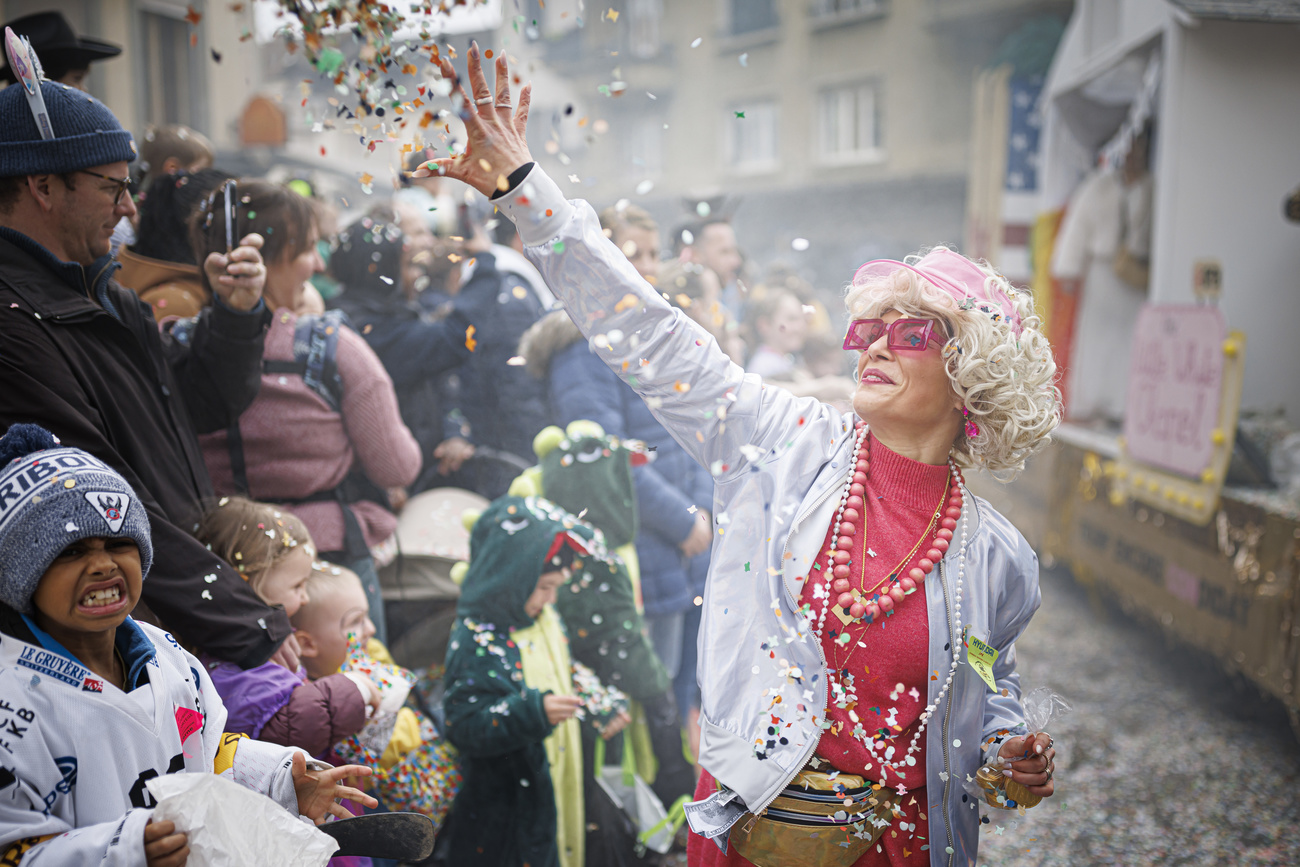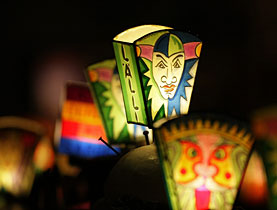
Swiss carnivals – a riot of colour, noise and tradition

Why do some young Swiss men dress up as fir trees for carnival and others carry colourful lanterns poking fun at the local authorities? A look at carnival traditions in Switzerland.
They may not be on the same scale as the raucous Rio Carnival, the hedonistic merry-making of Mardi Gras or the historic Venice Carnival with its lavish private parties, but carnival season across Switzerland is also an explosion of loud music, colourful masked parades, ancient traditions, satire and sheer fun to usher out winter and welcome in spring.
Carnival – known as Fasnacht in Swiss German – is the period just before Lent, the 40-day fast in the Christian calendar that precedes Easter. The Latin-based word “carnival” comes from “carnem levare” – to give up meat.
In the Alpine country these pre-Lent festivals are in many cases a blend of local pagan and Catholic traditions and vary from region to region.
‘To let off steam before Lent’
“Carnival was born from a need to let off steam before the constraints of Lent,” according to the Historical Dictionary of SwitzerlandExternal link. The oldest mentions of carnival in Switzerland date back to the late Middle Ages, it says. The word Fasnacht first appeared in 1283, but the first recorded carnival event was in Basel in 1418.
Today’s biggest and perhaps best-known Swiss carnival takes place every year in Protestant Basel as the climax of the season. It begins in defiance of Catholic traditions at 4am on the Monday after Ash Wednesday with the colourful “Morgenstraich” (or “morning prank”). In the early hours, thousands of spectators line the narrow streets to watch processions of masked revellers in wild-and-wonderful costumes carrying imaginative home-made lanterns. Fife-players and drummers from so-called cliques join the processions alongside other musicians. They march in time, revealing the military influences of times gone by.
The Basel carnival, which boasts UNESCO heritage statusExternal link, has evolved over time. It is not clear how it managed to survive the Reformation. The authorities tried to forbid carnival in 1546, arguing that as Protestants had abolished the fasting period, pre-Lent exuberance was no longer needed. The celebration survived, but it was not always popular. Today the three days of festivities attract around 200,000 visitors.
As well as its mesmerising costumes and music, Basel’s Fastnacht is also known for its social and political criticismExternal link and displays of resistance. Cliques poke fun at current events or well-known figures, while “Schnitzelbänkler” singers perform songs mocking the local or federal authorities.

More
Old carnival traditions die hard
“The carnival can be compared to a huge satirical magazine where all visual or rhetorical means are used to make fun of flaws and blunders,” says UNESCO.
Raucous parties
Big, noisy carnivals were also held this month in LucerneExternal link, which this year attracted 298,000 people, and in Bellinzona, known as RabadanExternal link, in southern Switzerland, which pulled in 140,000.
With its rousing Guggenmusik big bands and creative costumes, Lucerne’s six-day carnival opened on “Dirty Thursday”, the Thursday before Lent. Dirt also means grease in the Swiss-German dialect, and the name is a reference to the sausages eaten in Lucerne so that its predominantly Catholic population could build up reserves of fat before fasting begins during Lent.
Food is a common theme at Swiss carnivals. Fasnacht used to be a time for the towns’ wealthy tradesmen to distribute food to the poor. Today, mountains of oranges, rolls, and sausages are given to children by masked and costumed figures. In Lugano, Locarno, Ascona, Bellinzona and many smaller towns in Italian-speaking Switzerland, pots of risotto are prepared outside and shared.
Pagan traditions
Carnival traditions vary widely. Some Swiss regions still carry on ancient pagan traditions such as wearing fearsome masks and costumes or lighting fires to chase away winter’s demons.
The “Böögg”, a straw man representing winter, is burned to mark the end of Fasnacht in Solothurn. In Liestal, canton Basel Country, men and women march through the streets carrying broom-shaped flaming torches and pulling metal carts filled with burning wood to bring light and hope for brighter days.

Meanwhile, in the Lötschental region in canton Valais, hideous masked and costumed figures, known as “Tschäggättä”, roam the Alpine valley in the evenings to scare away evil winter spirits. This year for the first time they were assisted by “empaillés”, so-called “straw men” from the nearby mountain village of Evolène who wear suits stuffed with up to 30kg of straw.
And in Le Noirmont, in canton Jura, young men covered in fir branches and ivy took part in the night-time “Sortie des SauvagesExternal link” [Night of the Wild men]. This playful traditionExternal link involves the tree-like figures trying to catch local young women and duck them in fountains and marks the start of the Franches-Montagnes carnival, known as the Carimentran.

More
The dark Swiss fertility tradition with hunters and ‘victims’

In compliance with the JTI standards
More: SWI swissinfo.ch certified by the Journalism Trust Initiative













































You can find an overview of ongoing debates with our journalists here . Please join us!
If you want to start a conversation about a topic raised in this article or want to report factual errors, email us at english@swissinfo.ch.